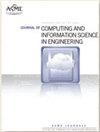低碳足迹的数字双驱动产品可持续设计
IF 2.6
3区 工程技术
Q2 COMPUTER SCIENCE, INTERDISCIPLINARY APPLICATIONS
Journal of Computing and Information Science in Engineering
Pub Date : 2023-04-27
DOI:10.1115/1.4062427
引用次数: 1
摘要
产品的可持续性是一个迫切需要改进的全球性问题,而低碳设计是实现可持续产品开发的关键途径。连接物理世界和虚拟世界的数字孪生技术已经成为支持产品设计和开发的有效工具。然而,获得准确的产品参数仍然是一个挑战,传统的低碳产品设计主要侧重于设计参数。为了解决这些问题,本文提出了一种利用物联网在整个产品生命周期中收集数据的方法。本文设想了产品生命周期数据的自动采集,以提高产品设计的准确性。此外,传统的低碳设计往往范围有限,主要考虑产品结构和生命周期阶段进行优化。相比之下,将数字孪生技术与低碳设计相结合可以有效地提高产品的可持续性。为此,本文提出了产品可持续性数字孪生的三层架构模型,包括数据层、映射层和应用层。该模型以碳足迹为迭代优化目标,有利于产品闭环可持续设计。本文设想了基于数字孪生的可持续产品设计,可以解决级联问题,实现闭环可持续设计。本文章由计算机程序翻译,如有差异,请以英文原文为准。
Digital Twin-Driven Product Sustainable Design for Low Carbon Footprint
Product sustainability is a pressing global issue that requires urgent improvement, and low-carbon design is a crucial approach towards achieving sustainable product development. Digital twin technology, which connects the physical and virtual worlds, has emerged as an effective tool for supporting product design and development. However, obtaining accurate product parameters remains a challenge, and traditional low-carbon product design primarily focuses on design parameters. To address these issues, this paper proposes a method for data collection throughout the product lifecycle, leveraging the Internet of Things. The paper envisions the automatic collection of product lifecycle data to enhance the accuracy of product design. Moreover, traditional low-carbon design often has a limited scope that primarily considers product structure and lifecycle stage for optimization. In contrast, combining digital twin technology with low-carbon design can effectively improve product sustainability. Therefore, this paper proposes a three-layer architecture model of product sustainability digital twin, comprising data layer, mapping layer, and application layer. This model sets the carbon footprint as the iterative optimization goal and facilitates the closed-loop sustainable design of the product. The paper envisions sustainable product design based on digital twins that can address cascading problems and achieve closed-loop sustainable design.
求助全文
通过发布文献求助,成功后即可免费获取论文全文。
去求助
来源期刊
CiteScore
6.30
自引率
12.90%
发文量
100
审稿时长
6 months
期刊介绍:
The ASME Journal of Computing and Information Science in Engineering (JCISE) publishes articles related to Algorithms, Computational Methods, Computing Infrastructure, Computer-Interpretable Representations, Human-Computer Interfaces, Information Science, and/or System Architectures that aim to improve some aspect of product and system lifecycle (e.g., design, manufacturing, operation, maintenance, disposal, recycling etc.). Applications considered in JCISE manuscripts should be relevant to the mechanical engineering discipline. Papers can be focused on fundamental research leading to new methods, or adaptation of existing methods for new applications.
Scope: Advanced Computing Infrastructure; Artificial Intelligence; Big Data and Analytics; Collaborative Design; Computer Aided Design; Computer Aided Engineering; Computer Aided Manufacturing; Computational Foundations for Additive Manufacturing; Computational Foundations for Engineering Optimization; Computational Geometry; Computational Metrology; Computational Synthesis; Conceptual Design; Cybermanufacturing; Cyber Physical Security for Factories; Cyber Physical System Design and Operation; Data-Driven Engineering Applications; Engineering Informatics; Geometric Reasoning; GPU Computing for Design and Manufacturing; Human Computer Interfaces/Interactions; Industrial Internet of Things; Knowledge Engineering; Information Management; Inverse Methods for Engineering Applications; Machine Learning for Engineering Applications; Manufacturing Planning; Manufacturing Automation; Model-based Systems Engineering; Multiphysics Modeling and Simulation; Multiscale Modeling and Simulation; Multidisciplinary Optimization; Physics-Based Simulations; Process Modeling for Engineering Applications; Qualification, Verification and Validation of Computational Models; Symbolic Computing for Engineering Applications; Tolerance Modeling; Topology and Shape Optimization; Virtual and Augmented Reality Environments; Virtual Prototyping

 求助内容:
求助内容: 应助结果提醒方式:
应助结果提醒方式:


